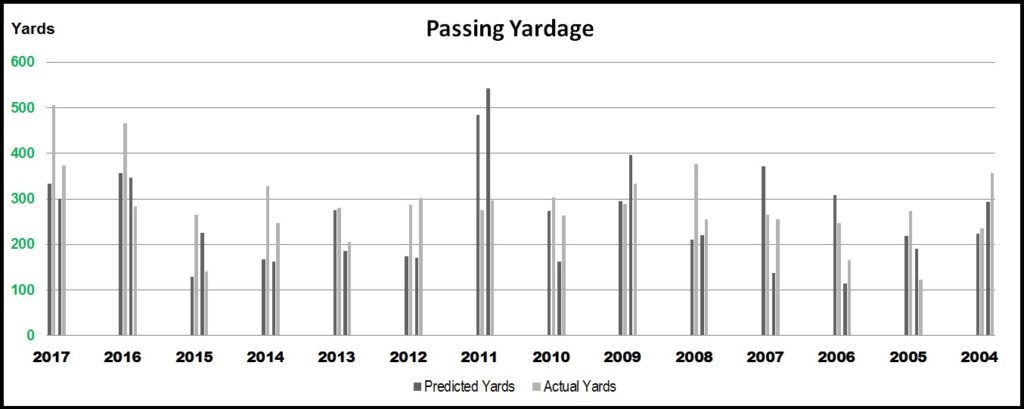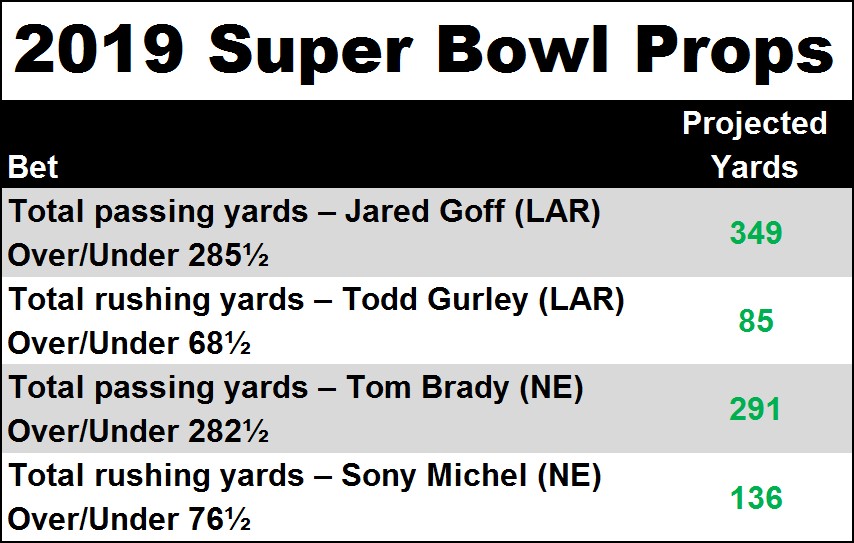Saying that people love wagering on the Super Bowl is like saying that Charlie Sheen kinda-sorta enjoys a night out on the town. Last year, it was estimated that $4.7 billion was bet both legally and illegally on the big event — an amount nearly double the GDP of Aruba, which, incidentally, just instituted a new “sin tax”, thereby assuring that Sheen will never vacation there.

And each year an increasing amount of moolah is staked on the various proposition, or “prop”, bets. This year, in addition to the annual absurdity of betting on the opening coin toss — who does this? — bettors can also risk their paycheck on how often Sean McVay’s age is mentioned and whether or not Tony Romo will say “here we go” on the television broadcast of the game.
Now, while most proposition betting makes about as much sense as watching an Adam Sandler movie for the plot twists, there are a few props that a serious Super Bowl bettor can sink his/her teeth into, mainly wagers on team and player totals.
In fact, by normalizing each Super Bowl team’s statistics — a process so basic that Nate Silver would likely choke on his own snarky comments (and then roll over in his grave) if he read this — one can get a fairly good idea as to how the big game will play out.

I won’t bore you with the math, but if you take a peek at the chart above, you’ll see that only twice since 2004 has the team that was projected to throw for more yards failed to do so. That was in 2008, when Kurt Warner toasted Pittsburgh’s league-leading pass defense for 377 yards and three scores, and in 2016, when Cam Newton threw the ball 41 times — when he wasn’t getting sacked by Super Bowl MVP Von Miller — to outgain the aging and injured Peyton Manning.
Overall, each team’s actual passing yardage exceeded expectations by an average of 26 yards.
Likewise, the projected rushing yardage, gives a solid clue as to which teams are likely to pound the rock successfully (with the average predicted total just six yards over the actual team total since 2004).

Now, granted, this (very) simple method of projecting yardage is wildly inconsistent and, hence, not well-suited to make definitive predictions, but it does do a fairly decent job of pointing out over/under lines that can be exploited, especially those pertaining to the running game.
For example, in Super Bowl XLV, Green Bay running back James Starks had an O/U line of 52 ½ rushing yards, despite the fact that the Packers, as a team, were projected to gain just 31 yards on the ground.
Starks made it interesting, but, ultimately, he finished under the total by a half-yard.
Likewise, in Super Bowl XLIII, both Willie Parker of the Pittsburgh Steelers and Edgerrin James of the Arizona Cardinals had over/under rushing totals that met or exceeded the expected output of their teams. Both players finished under those totals.
So, what does all this mean for Sunday’s super showdown? Well, let’s take a look at some popular prop bets on the big game:

Since 2004, quarterbacks that were projected to throw for more yards than the bookmakers expected, did so five out of nine times. When the total was less than 310 yards, the “over” cashed four times out of five (granted, not a huge sample, but good news for both Goff and Brady).
On the rushing side, running backs predicted to go under the total were down for the task (see what I did there?) eight times out of 11, returning over 42 cents on every dollar wagered. However, those projected to go over the total managed the feat just eight times in 18 tries, resulting in a hefty loss.
With that said, I do find Todd Gurley intriguing, as he’s averaged just 10 carries a game in the playoffs after averaging 18.3 totes per game in the regular season. Rams head coach McVey said his star running back, who has had some injury problems, is “feeling good, a hundred percent” and added that he expected Gurley to “play a big role in [the Super Bowl].”
If that is, in fact, the case, I think Gurley would be a good bet to exceed the 68½ yards expected of him.
